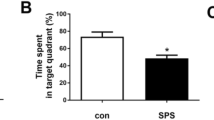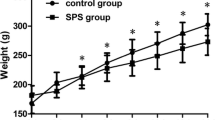Summary
Death following situations of intense emotional stress has been linked to the cardiac pathology described as stress cardiomyopathy, whose pathomechanism is still not clear. In this study, we sought to determine, via an animal model, whether the transcriptional coactivator peroxisome proliferator-activated receptor γ coactivator-1alpha (PGC-1α) and the amino peptide neuropeptide Y (NPY) play a role in the pathogenesis of this cardiac entity. Male Sprague-Dawley rats in the experimental group were subjected to immobilization in a plexy glass box for 1 h, which was followed by low voltage electric foot shock for about 1 h at 10 s intervals in a cage fitted with metallic rods. After 25 days the rats were sacrificed and sections of their hearts were processed. Hematoxylin-eosin staining of cardiac tissues revealed the characteristic cardiac lesions of stress cardiomyopathy such as contraction band necrosis, inflammatory cell infiltration and fibrosis. The semi-quantitative RT-PCR analysis for PGC-1α mRNA expression showed significant overexpression of PGC1-α in the stress-subjected rats (P<0.05). Fluorescence immunohistochemistry revealed a higher production of NPY in the stress-subjected rats as compared to the control rats (P=0.0027). Thus, we are led to conclude that following periods of intense stress, an increased expression of PGC1-α in the heart and an overflow of NPY may lead to stress cardiomyopathy and even death in susceptible victims. Moreover, these markers can be used to identify stress cardiomyopathy as the cause of sudden death in specific cases.
Similar content being viewed by others
References
Cebelin MS, Hirsch CS. Human stress cardiomyopathy. Myocardial lesions in victims of homicidal assaults without internal injuries. Hum Pathol, 1980,11(2):123–132
Macovei L, Coadă G, Constantinescu V, et al. Takotsubo cardiomyopathy. Rev Med Chir Soc Med Nat Iasi, 2012,116(1):139–144
Kawai S, Suzuki H, Yamaguchi H, et al. Ampulla cardiomyopathy (“takotsubo” cardiomyopathy) reversible left ventricular dysfunction with ST segment elevation. Jpn Circ J, 2000,64(2):156–159
Bybee KA, Kara T, Prasad A, et al. Systematic review: transient left ventricular apical ballooning: a syndrome that mimics ST-elevation myocardial infarction. Ann intern Med, 2004,141(11):858–865
Crea F, Lanza GA. Angina pectoris and normal coronary arteries: cardiac syndrome X. Heart, 2004,90(4):457–463
Bugiardini R, Badimon L, Collins P, et al. Angina, “Normal” Coronary Angiography, and Vascular Dysfunction: Risk Assessment Strategies. PLoS Med, 2007, 4(2):e12
Wittstein IS. Stress cardiomyopathy: a syndrome of catecholamine-mediated myocardial stunning? Cell Mol Neurobiol, 2012,32(5):847–857
Lanza GA, Andreotti F, Sestito A, et al. Platelet aggregability in cardiac syndrome X. Eur Heart J, 2001,22(20):1924–1930
Raju H, Alberg C, Sagoo GS, et al. Inherited cardiomyopathies. BMJ, 2011,21(343):1106–1110
Breuer ME, Willems PH, Russel FG, et al. Modeling mitochondrial dysfunctions in the brain: from mice to men. J Inherit Metab Dis, 2012,35(2):193–210
García-Giménez JL, Gimeno A, Gonzalez-Cabo P, et al. Differential expression of PGC-1α and metabolic sensors suggest age-dependent induction of mitochondrial biogenesis in Friedreich ataxia fibroblasts. PLoS One, 2011,6(6):e20666
Macario AJ, Conway de Macario E. Sick chaperones, cellular stress, and disease. N Engl Med, 2005,353(14):1489–1501
Salomon P, Halawa B. Levels of neuropeptide Y and thromboxane B2 in patients with variant angina. Pol Arch Med Wewn, 1998,100(4):313–320
Leone TC, Lehman JJ, Finck BN, et al. PGC-1a-deficiency causes multi-system energy metabolic derangements: Muscle dysfunction, abnormal weight control and hepatic steatosis. PLoS Biol, 2005,3(4):e101
Kelly DP, Scarpulla RC. Transcriptional regulatory circuits controlling mitochondrial biogenesis and function. Genes Dev, 2004,18(4):357–368
Puigserver P, Wu Z, Park CW, et al. A cold inducible coactivator of nuclear receptors linked to adaptive thermogenesis. Cell, 1998,92(6):829–839
Lehman JJ, Barger PM, Kovacs A, et al. Peroxisome proliferator-activated receptor γ coactivator-1 promotes cardiac mitochondrial biogenesis. J Clin Invest, 2000, 106(7):847–856
Russell LK, Mansfield CM, Lehman JJ, et al. Cardiac-specific induction of the transcriptional coactivator peroxisome proliferators-activated receptor-γ coactivator-1α promotes mitochondrial biogenesis and reversible cardiomyopathy in a developmental stage dependent manner. Circ Res, 2004,94(4):525–533
St-Pierre, Lin JD, Krauss S, et al. Bioenergetic analysis of peroxisome proliferator-activated receptor gamma coactivators 1alpha and 1beta (PGC-1α and PGC-1β) in muscle cells. J Biol Chem, 2003,278 (29):26597–26603
Herzig S, Long F, Jhala US, et al. CREB regulates hepatic gluconeogenesis through the coactivator PGC-1. Nature, 2001,413 (6852):179–183
Rhee J, Inoue Y, Yoon JC, et al. Regulation of hepatic fasting response by PPARgamma coactivator-1alpha (PGC-1): requirement for hepatocyte nuclear factor 4alpha in gluconeogenesis. Proc Natl Acad Sci USA, 2003,100(7):4012–4017
Allen JM, Adrian TE, Tatemoto K, et al. Two novel related peptides, neuropeptide Y (NPY) and peptide YY (PYY) inhibit the contraction of the electrically stimulated mouse vas deferens. Neropeptides, 1982,3(2):71–77
Gu J, Polak JM, Allen JM, et al. High concentrations of a novel peptide, neuropeptide Y, in the innervation of mouse and rat heart. J Histochem Cytochem, 1984,32(5):467–472
Rudehill A, Sollevi A, Franco-Cereceda A, et al. Neuropeptide Y (NPY) and the pig heart: release and coronary vasoconstrictor effects. Peptides, 1986,7(5):821–826
Gullestad L, Pernow J, Bjurö T, et al. Differential effects of metoprolol and atenolol to neuropeptide Y blockade in coronary artery disease. Scand Cardiovasc J, 2012,46(1):23–31
Morgan CA 3rd, Wang S, Southwick SM, et al. Plasma neuropeptide-Y concentrations in humans exposed to military survival training. Biol Psychiatry, 2000,47(10):902–909
Gómez-Ambrosi J, Frühbeck G, Martínez JA. Rapid in vivo PGC-1 mRNA upregulation in brown adipose tissue of Wistar rats by a β-(3)-adrenergic agonist and lack of effect of leptin. Mol Cell Endocrinol, 2001,176(1–2):85–90
Finck BN, Kelly DP. Peroxisome proliferator-activated receptor gamma coactivator-1 (PGC-1α) regulatory cascade in cardiac physiology and disease. Circulation, 2007,115(19):2540–2548
Russell LK, Finck BN, Kelly DP. Mouse models of mitochondrial dysfunction and heart failure. J Mol Cell Cardiol, 2005,38(1):81–91
Ventura-Clapier R, Garnier A, Veksler V. Energy metabolism in heart failure. J Physiol, 2004,555 (pt1):1–13
van Bilsen M, van Nieuwenhoven FA, van der Vusse GJ. Metabolic remodelling of the failing heart: beneficial or detrimental? Cardiovasc Res, 2009,81(3):420–428
Cocco G, Chu D. Stress-induced cardiomyopathy: A review. Eur J Intern Med, 2007,18(5):369–379
Sebastiani M, Giordano C, Nediani C, et al. Induction of mitochondrial biogenesis is a maladaptive mechanism in mitochondrial cardiomyopathies. J Am Coll Cardiol, 2007,50(14):1362–1369
Stoney CM, Hughes JW. Catecholamine stress responses in arterialized blood. Psychophysiology, 2001,38(3):590–593
Zhang GX, Kimura S, Nishiyama A, et al. Cardiac oxidative stress in acute and chronic isoproterenol-infused rats. Cardiovasc Res, 2005,65(1):230–238
Chalkias A, Xanthos T. Pathophysiology and pathogenesis of post-resuscitation myocardial stunning. Heart Fail Rev, 2012,17(1):117–128
Arnold G, Kaiser C, Fischer R. Myofibrillar degeneration—a common type of myocardial lesion and its selective identification by a modified luxol fast blue stain. Pathol Res Pract, 1985,180(4):405–415
Duflou J, Nickols G, Waite P, et al. Artefactual contraction band necrosis of the myocardium in fatal air crashes. Aviat Space Environ Med, 2006,77 (9):944–999
Schröder R, Schoser B. Myofibrillar myopathies: a clinical and myopathological guide. Brain Pathol, 2009,19(3):483–492
Machackova J, Barta J, Dhalla NS. Myofibrillar remodelling in cardiac hypertrophy, heart failure and cardiomyopathies. Can J Cardiol, 2006,22(11):953–968
Murakami T, Tanaka N. The physiological significance of coronary aneurysms in Kawasaki disease. EuroIntervention, 2011,7(8):944–947
Wittstein IS, Thiemann DR, Lima JA, et al. Neurohumoral features of myocardial stunning due to sudden emotional stress. N Engl J Med, 2005,352(6):539–548
Silva AP, Xapelli S, Grouzmann E, et al. The putative neuroprotective role of neuropeptide Y in the central nervous system. Curr Drug Targets CNS Neurol Disord, 2005,4(4):331–347
García-Villalón AL, Padilla J, Fernández N, et al. Effect of neuropeptide Y on the sympathetic contraction of the rabbit central ear artery during cooling. Pflugers Arch, 2000,440(4):548–555
Warner MR, Senanayake PD, Ferrario CM, et al. Sympathetic stimulation-evoked overflow of norepinephrine and neuropeptide Y from the heart. Circ Res, 1991,69(2):455–465
Author information
Authors and Affiliations
Corresponding author
Additional information
The two authors contributed equally to this work.
This project was supported by a grant from the National Natural Science Foundation of China (No. 81172898).
Rights and permissions
About this article
Cite this article
Ananda, S., Wang, Y., Zhu, S. et al. Role of neuropeptide Y and peroxisome proliferator-activated receptor γ coactivator-1α in stress cardiomyopathy. J. Huazhong Univ. Sci. Technol. [Med. Sci.] 32, 823–828 (2012). https://doi.org/10.1007/s11596-012-1041-3
Received:
Published:
Issue Date:
DOI: https://doi.org/10.1007/s11596-012-1041-3




